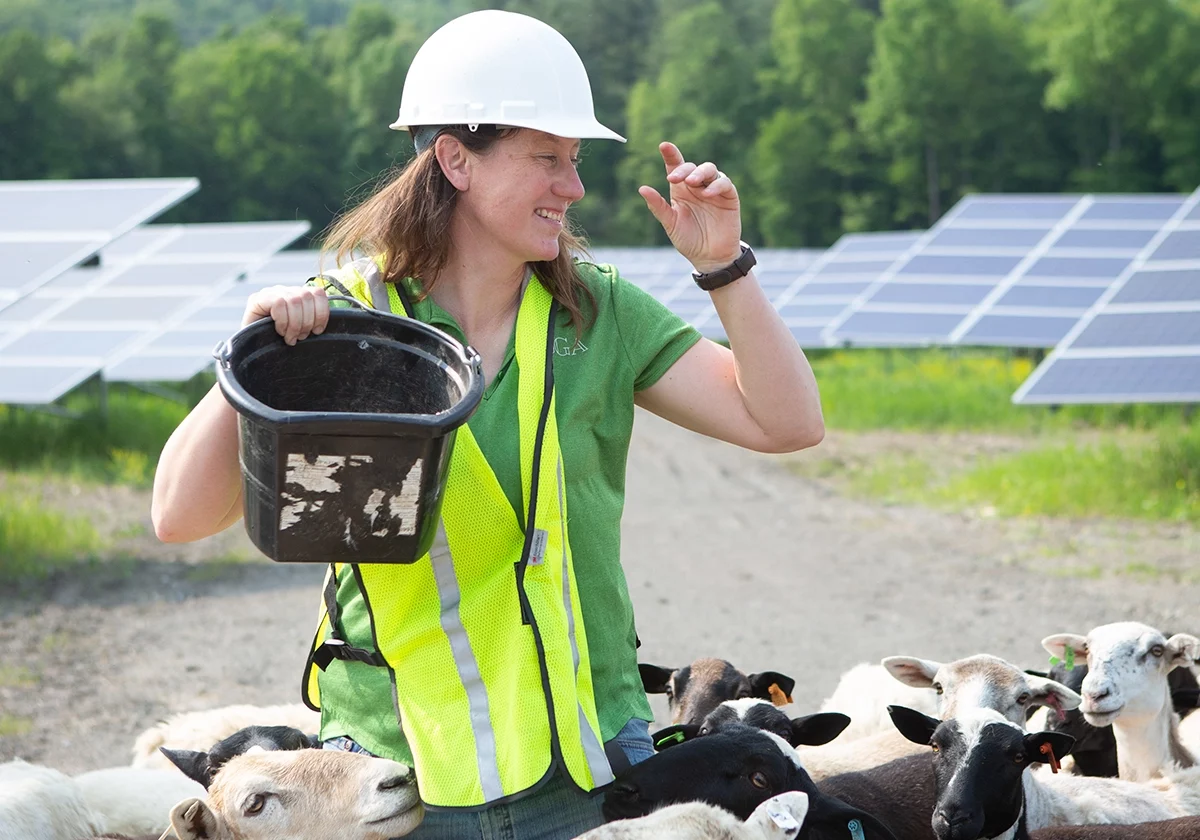Biggest Solar Farm in New Jersey to Partner with Experienced Solar Grazier, ASGA Member

The Nichomaus Run Solar Farm, proposed by developer Dakota Power Partners, would cover 800 acres of land in Pilesgrove Township — 650 of which will be lined with rows of roughly 4,000 solar panels. The land would provide grazing space for 1,000 sheep.Courtesy — Dakota Power Partners
By Caroline Fassett | NJ Advance Media for NJ.com
A solar farm may be built in South Jersey that will be larger than any solar Garden State project that’s come before it.
The Nichomaus Run Solar Farm, proposed by developer Dakota Power Partners, would cover 800 acres of land in Pilesgrove Township — 650 of which will be lined with rows of roughly 400,000 solar panels. If the project receives the necessary approvals, construction would begin in late 2021. It is currently before local Planning Board, with a public hearing continuing on Wednesday.
The solar farm, running to the east and west of County Home Road, northwest of Route 45, would become operational in 2022. While it will have the designation of being the largest solar farm in New Jersey, it will also be unique in that it will be home to 1,000 sheep.
“Usually we’ve got to pay people for the 30-year life of the project to go out and mow, and weed whack, and maintain the vegetation,” said Tim Daniels, president of Dakota Power Partners. “Eight hundred acres — it costs a lot. Now we have the sheep out there that can do this, and do it cost effectively.”
Roughly 1,000 ewes — as well as 50 rams during breeding season — will be living at the solar farm to manage vegetation growing under the panels. This arrangement creates a wide-range of benefits for the farm, including eliminating the costs of mechanical mowing and enhancing the general soil quality by eschewing the use of fertilizers and herbicides.
Julie Bishop, owner of Solar Sheep, LLC in Newfield and operator of numerous sheep farms across the state, highlighted the environmental advantages gained by using sheep.
“It’s pollinator-friendly,” Bishop explained. “The sheep are only eating the flowers off of one section at a time. So there’s going to be plenty of flowers moving in other areas at the same time, so the pollinators will never have to go without.
“And it’s better for the grasses … because you’re not constantly grazing just the good stuff; you’re grazing everything down to a more or less uniform level, and moving on and letting the grasses recover,” she added. “So it makes for a healthier ground cover.”
But of all farm animals, why are sheep specifically targeted for solar grazing? Because they’re “the best,” according to Bishop.
“Other livestock like cattle, horses, llamas, all that — they’re all too tall. And cattle like to rub on stuff and the panels aren’t really up to that,” Bishop said. “And goats are much more prone to chewing on stuff and climbing on stuff.”
Of the several sheep farms that Bishop oversees throughout the state, this is the first that will be set up “with the sheep in mind,” she added.
“All the other solar farms where I’m at, they built the farms and I approached them to put the sheep there. So it’s not really built for sheep; it’s retrofitted as best as they can,” Bishop explained.
More may soon follow this project’s lead. According to Michael L. Westendorf, an extension specialist in Livestock and Dairy for Rutgers University that works closely with the state Department of Agriculture, there’s a “significant market” for livestock meat, including that of sheep.
“The sheep that come off the sheep grazing, they’re marketable meat and will be profit,” Westendorf explained. “A lot of the lamb meat that we consume in the United States comes from foreign countries. It’s slaughtered and processed for example in Australia, New Zealand, and gets marketed in the United States. So I think it’s a great way of promoting local markets and local farmers.
“There are some facilities in New Jersey, but maybe not enough, and maybe not really for the kind of producer we’re talking about — solar grazing. But there’s definitely a market,” he added.
The solar farm support between 200 and 300 construction jobs as well as three to five long-term, full-time jobs after it is operational. “It’s a lot of high-paying union jobs, and that’s why the unions are so thrilled about these projects,” Daniels said.

The solar farm is expected to generate an additional $942,000 in annual property tax revenue over the current $20,000 generated by the farm. Dakota Power Partners projects the project will pump around $10 million into the local economy during the construction phase.
“These towns in South Jersey are having a hard time. They’re already downsizing — now with (COVID-19), that’s exacerbated the problem. So there’s a lot of benefits economically for the local community,” Daniels said.
The project would also help meet the 2019 Energy Master Plan, unveiled by Gov. Phil Murphy in January, which establishes a goal of setting New Jersey on the path to achieving 100% clean energy by 2050. Some 34% of the state’s electric supply would come from solar powered sources, requiring the generation of 20,000 to 30,000 megawatts of solar energy.
As of present day, the state generates approximately 3,500 megawatts of solar energy — a comparatively small number that has caught the attention of state legislators. Throughout its 30-year project life, the solar farm will generate a peak output of approximately 150 megawatts of power, an annual generation equivalent to the demand from 24,000 New Jersey homes. This power will be sold into the PJM (Pennsylvania, Jersey, Maryland) wholesale electricity market.
According to Senator Bob Smith (D-17), chair of the Environment and Energy Committee for the New Jersey Senate, there is “no way” the state is “ever going to meet our Energy Master Plan goals … unless we find ways to get more solar done.”
“Right now, 5% of the energy needs of New Jersey are provided by solar energy — and to a large extent, it’s rooftop solar, or stuff you put on the top of your home,” he added.
Smith and Senator Kip Bateman (R-16) have introduced a bill in the Senate, included on Monday’s committee agenda, to direct the state Board of Public Utilities to establish a utility-scale solar energy development program.
Smith is also working on a separate bill to advance dual-use solar energy development. This legislation would support projects like Nichomaus Run Solar Farm.
“I get a little criticism from the enviros saying, ‘How could you do that? How could you put solar on a farm?’ But first of all, for dual-use solar, it’s not an issue — because a farm stays a farm,” Smith said. “The farming community is greatly in support of the dual-use. And they’re not opposed to the grid-scale either; but the dual-use is like a grand slam home run, because you continue to farm and you also get revenue from the rental of the property for solar.”



